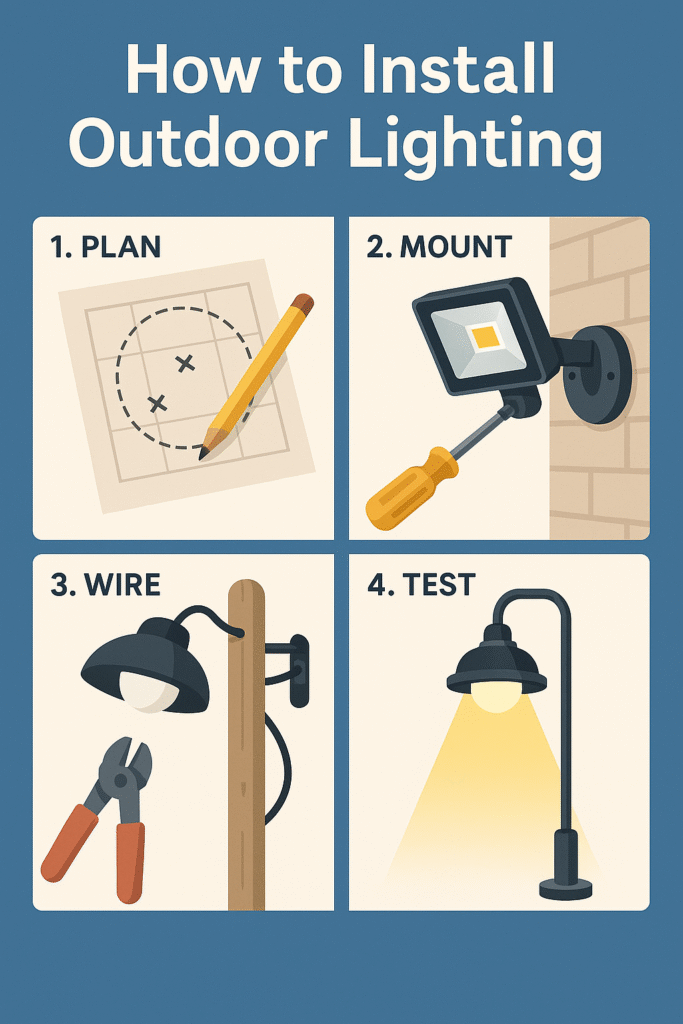Outdoor Lighting Installation: A Detailed Overview
Proper installation of outdoor lighting is crucial for maximizing its effectiveness, ensuring safety, and enhancing the overall aesthetics of an outdoor space. Whether you’re lighting up a commercial property, parking lot, street, or any other outdoor area, understanding the installation process and requirements is key. Below is a detailed breakdown of the outdoor lighting installation process, components, and best practices.
1. Planning and Design
Before you begin the installation process, it’s essential to plan the layout of your outdoor lighting system to ensure it meets both functional and aesthetic goals.
Steps for Planning:
- Determine Lighting Requirements: Assess the area that needs lighting and the purpose of the lighting (e.g., security, ambiance, task lighting, etc.).
- Choose Lighting Types: Select the appropriate lighting fixtures (e.g., floodlights, wall packs, streetlights, landscape lights) based on the area and purpose.
- Consider Energy Efficiency: Opt for energy-efficient solutions such as LED or solar-powered lights.
- Placement of Fixtures: Strategically place lights for maximum coverage. For security lighting, focus on dark corners, entrances, and pathways. For decorative lighting, focus on focal points like trees, gardens, or architectural features.
- Evaluate Power Sources: Decide whether you will use standard electrical connections, solar panels, or battery-powered lights. For hardwired systems, ensure there’s access to a power source, or plan for underground wiring if necessary.
Tools and Equipment Needed for Planning:
- Measuring Tape: For measuring distances and spacing between lights.
- Lighting Design Software (optional): Some lighting designers use tools to simulate the layout and lighting effects. Lighting Design Software – LightCalc
- Electrical Plan: Create a blueprint for wiring and power connections, especially for hardwired systems.

2. Choosing the Right Components
Choosing the right lighting components is essential for proper installation and system performance. Below are the key components needed for outdoor lighting installation:
Key Components:
- Lighting Fixtures: Choose from floodlights, bollard lights, post-top lights, wall pack lights, landscape lights, or decorative fixtures depending on the installation needs.
- Wiring and Cables: Use durable, weather-resistant cables for wiring hardwired systems. Ensure they are rated for outdoor use. Outdoor Wiring Guide – The Home Depot
- Power Supply/Transformers: For low-voltage lighting systems, you will need a transformer to convert high-voltage electricity to low-voltage for the lights.
- Switches and Dimmers: Install timers, dimmers, or smart switches to control light intensity and energy consumption. Smart Switches – Lutron
- Mounting Poles and Brackets: For streetlights or larger fixtures, ensure the correct poles and mounting systems are in place for secure fixture installation. Outdoor Lighting Mounting – Musco Lighting
- Solar Panels (if applicable): For solar-powered lighting, ensure proper placement of the solar panels to receive sufficient sunlight throughout the day. Solar Lighting Guide – Solar Power World
3. Installation Steps for Outdoor Lighting
Step 1: Mark and Prepare the Installation Area
- Measure and Mark Light Locations: Use your planned layout to mark where each light fixture will be installed. Ensure the spacing between lights provides adequate coverage for the area.
- Check for Existing Underground Utilities: Before digging or installing poles, confirm that there are no underground utilities or obstacles. This can be done by consulting utility maps or using a “dig alert” service. DigSafe – USA
Step 2: Install Poles and Fixtures (for Pole-Mounted or Wall-Mounted Lights)
- Pole Installation (for Streetlights/Floodlights):
- Dig a hole for each pole, ensuring it’s deep enough for stability (usually 2-3 feet deep for typical outdoor poles).
- Place the pole in the hole, level it, and pour concrete to secure it in place. Let the concrete set before proceeding with fixture attachment.
- Install mounting brackets on the pole and attach the fixture to the bracket securely.
- Wall-Mounted Fixtures: For wall-mounted lighting, ensure the fixture is securely attached to the wall using screws or anchors appropriate for the surface type. Wall Mount Lighting Installation – LED Light Guide
Step 3: Wiring the System
- Low Voltage Lighting Systems:
- If you’re installing low-voltage lights, run a low-voltage cable from the power source or transformer to each light fixture. Make sure to bury the cables at least 6-12 inches underground (depending on local codes) to prevent damage.
- For connections, use waterproof connectors to ensure no moisture enters the wires.
- Use wire nuts or crimp connectors to securely join cables.
- High Voltage Lighting Systems:
- For standard high-voltage systems (120V or 240V), ensure that you have a qualified electrician handle the wiring to ensure compliance with electrical codes. Electrical Wiring Codes – National Electrical Code
Step 4: Installing Solar-Powered Lights (If Applicable)
- Panel Placement: Install the solar panel in an area where it will receive maximum sunlight exposure. Ensure it is facing south (in the Northern Hemisphere) or north (in the Southern Hemisphere) for optimal performance.
- Light Placement: Mount the lights in the desired locations, ensuring that the solar panels are not obstructed by trees or buildings.
Step 5: Test the System
- Once the wiring and fixtures are in place, test the lights to ensure they are working correctly.
- For smart lighting systems, configure the system for remote control or automated settings. Smart Outdoor Lighting Installation – Philips Hue
- For solar lights, check that the solar panel is charging and that the light turns on automatically at dusk.
4. Safety and Compliance
Code Compliance
- Local Codes and Permits: Ensure that your lighting installation meets local electrical codes. Certain installations (especially those involving high-voltage wiring) may require permits or inspections.
- Electrical Safety: Use outdoor-rated fixtures, cables, and connectors to avoid electrical hazards. Ensure all wiring is properly insulated and waterproof. Electrical Code Compliance – International Code Council
- Grounding: Properly ground all electrical systems to prevent electrical shock hazards.
Tools and Personal Protective Equipment (PPE)
- Tools:
- Drill, screwdriver, wire stripper, shovel (for digging), and conduit bender (for high-voltage systems).
- For high-voltage systems, specialized tools like voltage testers are essential. Electrical Tools – Klein Tools
- PPE: Wear gloves, safety glasses, and sturdy footwear to prevent injuries while installing lights.
5. Maintenance and Troubleshooting
After installation, periodic maintenance is essential for optimal performance and longevity of the outdoor lighting system.
Maintenance Tips:
- Regular Cleaning: Clean the fixtures and lenses to prevent dirt and debris buildup, which can reduce light output. Cleaning Guide – Lighting Research Center
- Check Solar Panels: For solar lights, periodically check that the solar panels are free from obstructions and clean to maintain charging efficiency.
- Inspect Wiring: Inspect cables and connections for wear and tear, especially in areas where the cables are buried or exposed to moisture.
- Replace Bulbs: Replace bulbs when they reach the end of their lifespan, or when they stop working. LED Bulb Replacement – Energy Star
Troubleshooting:
- Light Not Turning On: Check the power supply, circuit breakers, and light switches. For solar-powered lights, ensure that the panel is receiving enough sunlight. Solar Lighting Troubleshooting – Solar Electric Supply
- Flickering Lights: This may indicate a loose connection or a faulty ballast (for traditional lighting systems). Check all connections and replace the ballast if needed. Ballast Troubleshooting – Lutron
Conclusion:
Proper installation of outdoor lighting systems is critical for ensuring safety, functionality, and aesthetics. Whether you’re installing security lights, pathway lighting, or decorative fixtures, careful planning, correct component selection, and adherence to safety codes are essential for achieving a long-lasting, effective lighting system. For more on outdoor lighting systems, check out our related articles on choosing the best lighting for your commercial space, how to buy from reliable suppliers, and tips for energy-efficient urban lighting solutions:
Energy Efficiency in Urban Lighting: The Benefits of Smart Streetlights

